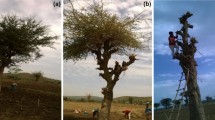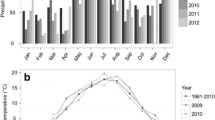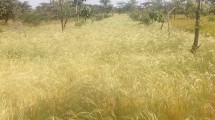Abstract
Integration of trees on farms may exert complementary or competitive effects on crop yield. This 4 year study examined novel systems in which Alnus acuminata (alnus), Calliandra calothyrsus (calliandra), Sesbania sesban (sesbania) or a mixture of all three were grown on the degraded upper part of bench terraces in Uganda; beans or maize were grown on the more fertile lower terrace during the short and long rains. Three pruning treatments (shoot, root or shoot + root pruning) were applied to the tree rows adjacent to the crops; shoot prunings were applied as green manure to the woodlot from which they came. Pruning increased survival in calliandra and reduced survival in sesbania; alnus was unaffected. Pruning reduced tree height and stem diameter in alnus, but did not affect calliandra or sesbania. Maize yield adjacent to unpruned calliandra, alnus and sesbania or a mixture of all three was reduced by 48, 17, 6 and 24% relative to sole maize. Shoot pruning initially sustained crop performance but shoot + root pruning became necessary when tree age exceeded 2 years; shoot + root pruning increased maize yield by 88, 40, 11 and 31% in the calliandra, alnus, sesbania and tree mixture systems relative to unpruned trees. Bean yield adjacent to unpruned calliandra, alnus, sesbania and the tree mixture was 44, 31, 33 and 22% lower than in sole crops and pruning had no significant effect on crop yield. The results suggest that sesbania fallows may be used on the upper terrace without reducing crop yield on the lower terrace, whereas pruning of alnus is needed to sustain yield. Calliandra woodlots appear to be unsuitable as crop yield was reduced even after pruning.





Similar content being viewed by others
References
Agus F, Cassel DK, Garrity DP (1997) Soil–water and soil physical properties under contour hedgerows on sloping oxisols. Soil Tillage Res 40:185–199. doi:10.1016/S0167-1987(96)01069-0
Bayala J, Ouedraogo SJ, Teklehaimanot Z (2008) Rejuvenating trees in agroforestry systems for better fruit production using crown pruning. Agrofor Syst 72:187–194. doi:10.1007/s10457-007-9099-9
Chandrashekara UM (2007) Effects of pruning on radial growth and biomass increment of trees growing in homegardens of Kerala, India. Agrofor Syst 69:231–237. doi:10.1007/s10457-007-9041-1
Cooper PJM, Leakey RRB, Rao MR, Reynolds L (1996) Agroforestry and the mitigation of land degradation in the humid and sub-humid tropics of Africa. Exp Agric 32:235–290. doi:10.1017/S0014479700026223
ICRAF (1994) Annual Report 1994. ICRAF, Nairobi, 239 pp
ICRAF (1995) Annual Report 1995. ICRAF, Nairobi, 288 pp
Jackson NA, Wallace JS, Ong CK (2000) Tree pruning as a means of controlling water use in an agroforestry system in Kenya. For Ecol Manage 126:133–148
Jones M, Sinclair FL, Grime VL (1998) Effect of tree species and crown pruning on root length and soil water content in semi-arid agroforestry. Plant Soil 201:197–207. doi:10.1023/A:1004324616942
Katende AB, Birnie A, Tengnas B (1995) Useful trees and shrubs for Uganda. Regional soil management unit (RSCU), Nairobi, 710 pp
Kwesiga F, Coe R (1994) The effect of short rotation Sesbania sesban planted fallows on maize yield. For Ecol Manage 64:199–208
Lott JE, Ong CK, Black CR (2000) Long term productivity of Grevillea robusta-based agroforestry systems in semi-arid Kenya II. Crop growth and system productivity. For Ecol Manage 139:187–201
Namirembe S, Brook RM, Ong CK (2009) Manipulating phenology and water relations in Senna spectabilis in a water limited environment in Kenya. Agrofor Syst. doi:10.1007/s10457-008-9169-7
Ong CK, Wilson J, Deans JD, Mulayta J, Raussen T, Wajja-Musukwe N (2002) Tree–crop interactions: manipulation of water use and root function. Agric Water Manage 53:171–186. doi:10.1016/S0378-3774(01)00163-9
Ong CK, Black CR, Muthuri CW (2006) Modifying forestry and agroforestry to increase water productivity in the semi-arid tropics. CAB reviews: perspectives in agriculture, veterinary science. Nutr Nat Resour 1(65):1–19
Ong CK, Anyango S, Muthuri CW, Black CR (2007) Water use and water productivity of agroforestry systems in the semi-arid tropics. Ann Arid Zone 46:255–284
Raussen T, Siriri D, Ong CK (1999) Trapping water, producing wood and improving yields through rotational woodlots on degraded parts of bench terraces in Uganda. East Afr Agric For J 65:85–93
Sanchez PA, Shepherd KD, Soule MJ, Place FM, Buresh RJ (1997) Soil fertility replenishment in Africa: an investment in natural resource capital. In: Buresh RJ, Sanchez PA, Calhoun PG (eds) Replenishing soil fertility in Africa, special publication 51. Soil Science Society of America, Madison, pp 1–46
Sande BD (2002) Pollarding and root pruning as management options for tree–crop competition and firewood production. MSc thesis, Department of Forestry Sciences, University of Stellenbosch, Republic of South Africa
Sanginga N, van Lauwe B, Danso SKA (1995) Management of biological N fixation in alley cropping systems–estimation and contribution to N balance. Plant Soil 174:119–141. doi:10.1007/BF00032244
Schroeder P (1995) Organic matter cycling by tropical agroforestry systems: a review. J Trop For Sci 7:462–474
Schroth G (1999) A review of below-ground interactions in agroforestry, focusing on mechanisms and management options. Agrofor Syst 43:5–34. doi:10.1023/A:1026443018920
Siriri D, Bekunda MA (2004) Soil fertility management in Uganda: the potential of agroforestry. In: Proceedings of Second National Agroforestry workshop, 10–14 Sept 2001, Mukono Uganda, ICRAF, Nairobi, pp 29–31
Siriri D, Raussen T (2003) Agronomic and economic potential of improved fallows on scoured terrace benches in the humid highlands of Southwestern Uganda. Agric Ecosyst Environ 95:359–369. doi:10.1016/S0167-8809(02)00046-4
Sun H, Tang Y, Xie J (2008) Contour hedgerow intercropping in the mountains of China: a review. Agrofor Syst 73:65–76. doi:10.1007/s10457-008-9113-x
Swinkels RA, Franzel S, Shepherd KD, Ohlsson E, Ndufa JK (1997) The economics of short rotation improved fallows: evidence from areas of high population in western Kenya. Agric Syst 55:99–121. doi:10.1016/S0308-521X(96)00098-4
TIST (2008) Planting trees and improving agriculture for better lives. http://www.tist.org/
Wajja-Musukwe T-N, Bamwerinde W, Siriri D, Mbalule M (1997) ICRAF-AFRENA Uganda. Progress report no. 121, ICRAF, Nairobi, 52 pp
Wajja-Musukwe T-N, Wilson J, Sprent JI, Ong CK, Deans JD, Okorio J (2008) Tree growth and management of Ugandan agroforestry systems: effects of root pruning on tree growth and crop yield. Tree Physiol 28:233–242
Wallace JS (1996) The water balance of mixed tree–crop systems. In: Ong CK, Huxley P (eds) Tree–crop interactions: a physiological approach. CAB International, Wallingford, pp 189–233
Yamoah CF, Agboola AA, Mulongoy K (1986) Soil properties as affected by the use of leguminous shrubs for alley cropping in maize. Agric Ecosyst Environ 18:167–177. doi:10.1016/0167-8809(86)90139-8
Acknowledgments
We thank the International Foundation for Science and USAID for funding, Thomas Raussen and Richard Coe for expert assistance with experimental design and statistical analysis, and Posiano Nteziryayo for trial management and data collection.
Author information
Authors and Affiliations
Corresponding author
Rights and permissions
About this article
Cite this article
Siriri, D., Ong, C.K., Wilson, J. et al. Tree species and pruning regime affect crop yield on bench terraces in SW Uganda. Agroforest Syst 78, 65–77 (2010). https://doi.org/10.1007/s10457-009-9215-0
Received:
Accepted:
Published:
Issue Date:
DOI: https://doi.org/10.1007/s10457-009-9215-0




